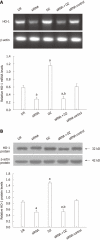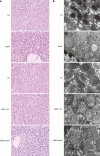Diazoxide attenuates ischemia/reperfusion injury via upregulation of heme oxygenase-1 after liver transplantation in rats
- PMID: 22553400
- PMCID: PMC3332289
- DOI: 10.3748/wjg.v18.i15.1765
Diazoxide attenuates ischemia/reperfusion injury via upregulation of heme oxygenase-1 after liver transplantation in rats
Abstract
Aim: To evaluate the effects of diazoxide on ischemia/reperfusion (I/R)-injured hepatocytes and further elucidate its underlying mechanisms.
Methods: Male Sprague-Dawley rats were randomized (8 for donor and recipient per group) into five groups: I/R group (4 h of liver cold ischemia followed by 6 h of reperfusion); heme oxygenase-1 (HO-1) small interfering RNA (siRNA) group (injection of siRNA via donor portal vein 48 h prior to harvest); diazoxide (DZ) group (injection of DZ via donor portal vein 10 min prior to harvest); HO-1 siRNA + DZ group; and siRNA control group. Blood and liver samples were collected at 6 h after reperfusion. The mRNA expressions and protein levels of HO-1 were determined by reverse transcription polymerase chain reaction and Western blotting, and tissue morphology was examined by light and transmission electron microscopy. Serum transaminases level and cytokines concentration were also measured.
Results: We observed that a significant reduction of HO-1 mRNA and protein levels in HO-1 siRNA and HO-1 siRNA + DZ group when compared with I/R group, while the increases were prominent in the DZ group. Light and transmission electron microscopy indicated severe disruption of tissue with lobular distortion and mitochondrial cristae damage in the HO-1 siRNA and HO-1 siRNA + DZ groups compared with DZ group. Serum alanine aminotransferase, aspartate transaminase, tumor necrosis factor-α and interleukin-6 levels increased in the HO-1 siRNA and HO-1 siRNA + DZ groups, and decreased in the DZ group.
Conclusion: The protective effect of DZ may be induced by upregulation of HO-1. By inhibiting expression of HO-1, this protection pretreated with DZ was abolished.
Keywords: Diazoxide; Heme oxygenase-1; Ischemia/reperfusion injury; Liver transplantation; Rat.
Figures





Similar articles
-
Heme oxygenase-1 induced in muller cells plays a protective role in retinal ischemia-reperfusion injury in rats.Invest Ophthalmol Vis Sci. 2004 Nov;45(11):4226-32. doi: 10.1167/iovs.04-0450. Invest Ophthalmol Vis Sci. 2004. PMID: 15505079
-
Contributions of heme oxygenase-1 in postconditioning-protected ischemia-reperfusion injury in rat liver transplantation.Transplant Proc. 2011 Sep;43(7):2517-23. doi: 10.1016/j.transproceed.2011.04.021. Transplant Proc. 2011. PMID: 21911116
-
Preconditioning donor liver with Nodosin perfusion lessens rat ischemia reperfusion injury via heme oxygenase-1 upregulation.J Gastroenterol Hepatol. 2012 Apr;27(4):832-40. doi: 10.1111/j.1440-1746.2011.06966.x. J Gastroenterol Hepatol. 2012. PMID: 22098251
-
[Effects of ischemic postconditioning on the expression of heme oxygenase-1 in the liver graft with ischemia and reperfusion injury in rats].Zhonghua Wai Ke Za Zhi. 2009 Sep 1;47(17):1343-6. Zhonghua Wai Ke Za Zhi. 2009. PMID: 20092734 Chinese.
-
Upregulation of heme oxygenase-1 protects genetically fat Zucker rat livers from ischemia/reperfusion injury.J Clin Invest. 1999 Dec;104(11):1631-9. doi: 10.1172/JCI7903. J Clin Invest. 1999. PMID: 10587527 Free PMC article.
Cited by
-
Levosimendan inhibits peroxidation in hepatocytes by modulating apoptosis/autophagy interplay.PLoS One. 2015 Apr 16;10(4):e0124742. doi: 10.1371/journal.pone.0124742. eCollection 2015. PLoS One. 2015. PMID: 25880552 Free PMC article.
-
Hydrogen-rich solution attenuates cold ischemia-reperfusion injury in rat liver transplantation.BMC Gastroenterol. 2019 Feb 8;19(1):25. doi: 10.1186/s12876-019-0939-7. BMC Gastroenterol. 2019. PMID: 30736744 Free PMC article.
-
Magnesium isoglycyrrhizinate protects hepatic L02 cells from ischemia/reperfusion induced injury.Int J Clin Exp Pathol. 2014 Jul 15;7(8):4755-64. eCollection 2014. Int J Clin Exp Pathol. 2014. PMID: 25197346 Free PMC article.
-
The mechanistic target of rapamycin (mTOR) pathway and S6 Kinase mediate diazoxide preconditioning in primary rat cortical neurons.J Neurochem. 2015 Sep;134(5):845-56. doi: 10.1111/jnc.13181. Epub 2015 Jul 1. J Neurochem. 2015. PMID: 26016889 Free PMC article.
-
A systematic review of pharmacological treatment options used to reduce ischemia reperfusion injury in rat liver transplantation.PLoS One. 2015 Apr 28;10(4):e0122214. doi: 10.1371/journal.pone.0122214. eCollection 2014. PLoS One. 2015. PMID: 25919110 Free PMC article.
References
-
- Noma A. ATP-regulated K+ channels in cardiac muscle. Nature. 1983;305:147–148. - PubMed
-
- Inoue I, Nagase H, Kishi K, Higuti T. ATP-sensitive K+ channel in the mitochondrial inner membrane. Nature. 1991;352:244–247. - PubMed
-
- Bajgar R, Seetharaman S, Kowaltowski AJ, Garlid KD, Paucek P. Identification and properties of a novel intracellular (mitochondrial) ATP-sensitive potassium channel in brain. J Biol Chem. 2001;276:33369–33374. - PubMed
-
- Debska G, May R, Kicińska A, Szewczyk A, Elger CE, Kunz WS. Potassium channel openers depolarize hippocampal mitochondria. Brain Res. 2001;892:42–50. - PubMed
-
- Debska G, Kicinska A, Skalska J, Szewczyk A, May R, Elger CE, Kunz WS. Opening of potassium channels modulates mitochondrial function in rat skeletal muscle. Biochim Biophys Acta. 2002;1556:97–105. - PubMed
Publication types
MeSH terms
Substances
LinkOut - more resources
Full Text Sources
Other Literature Sources
Medical

